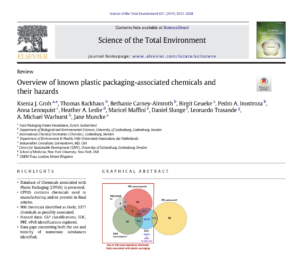This is a summary and explanation of the following research paper:
Overview of known plastic packaging-associated chemicals and their hazards
- Published In: Science of the Total Environment
- On: Feb 15, 2019

Key Takeaways:
- The study compiled a database called the CPPdb, which includes 4,283 substances that are likely or possibly associated with plastic packaging.
- The analysis found that for 60% of the substances in the CPPdb, no hazard data were available. The chemicals have not been sufficiently studied.
- The research identified 63 known chemicals associated with plastic packaging that are classified as “most hazardous” by the United Nations’ GHS (Global Harmonized System).
- The paper also identified 906 chemicals likely associated with plastic packaging and 3,377 more chemicals associated with plastics that could possibly associated with packaging.
- The 63 most hazardous chemicals identified in the study performed various functions in plastics, including acting as monomers, intermediates, solvents, surfactants, stabilizers, plasticizers, biocides, fire retardants, accelerators, and colorants.
About This Study
The authors of this study compiled a database called the CPPdb, which includes 4,283 substances that are likely or possibly associated with plastic packaging. These substances encompass raw materials and chemicals used in plastics manufacturing, such as monomers, polymerization aids, solvents, catalysts, and various additives.
Many chemicals used in making plastics, including packaging plastics, are highly hazardous, posing significant concerns for occupational health and the environment. These chemicals can transfer into products such as food or cosmetics during use, disposal, and recycling.
The study identified the most hazardous substances by consulting harmonized CLP classifications, advisory CLP classifications by the Danish EPA, EU-accepted classifications, and the UNEP report on Endocrine Disrupting Chemicals (EDCs).
What are harmonized CLP classifications?
Harmonized CLP (Classification, Labelling and Packaging) classifications refer to a system established under the CLP Regulation in the European Union. This system is designed to determine how substances and mixtures (including chemicals used in products) should be classified, labeled, and packaged safely. The key aspects of harmonized CLP classifications are:
- Classification: It involves identifying the hazardous properties of chemicals. This can include a range of hazards such as physical hazards (e.g., flammability), health hazards (e.g., toxicity, carcinogenicity), and environmental hazards (e.g., aquatic toxicity).
- Labelling: The CLP regulation requires that hazards are clearly communicated to consumers and workers handling the chemicals. This is achieved through standard labels that include hazard pictograms, signal words (like “Danger” or “Warning”), hazard statements, and precautionary statements.
- Packaging: Certain hazardous chemicals must be packaged in a way that minimizes the risk of exposure or accidents.
Harmonized CLP classifications are based on the Globally Harmonized System of Classification and Labelling of Chemicals (GHS), which is an internationally agreed-upon standard. The purpose of this harmonization is to ensure that the same set of rules for classifying and labeling chemicals is applied across different countries, enhancing safety and facilitating international trade.
In the context of the research paper on plastic packaging-associated chemicals, the harmonized CLP classifications would have been used to assess the hazards of the chemicals found in plastics, helping to identify those with the highest risks to human health and the environment.
How are chemicals associated with plastics classified?
There are various systems and organizations that classify chemicals by type, impact to human health, impact to the environment, and much more. There are also international systems that help to standardize these classifications.
Full Explanation: How are chemicals associated with plastics classified?
